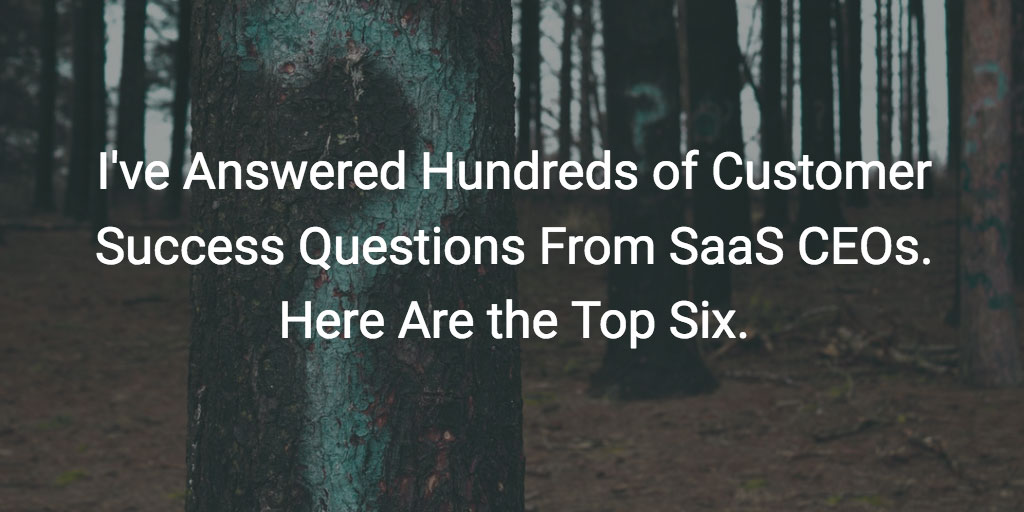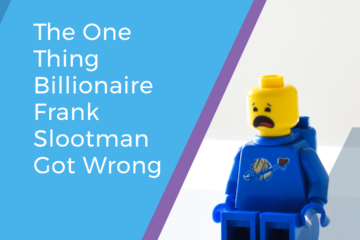I’ve Answered Hundreds of Customer Success Questions From SaaS CEOs. Here Are the Top Six.

I don’t know about you, but I constantly think about measuring my life in “moments.”
Some of those measurements are profound. How many more Christmases will we have all together with our entire extended family? How many Saturday daddy-and-kid brunches do I get with my three little ones while they’re still somewhat little? How many more reunion getaway weekends will I have with my college roommates? No matter what, the answer seems destined to be “too few.”
And some moments are more likely to fall into the category of “too many.” Like, how many hours of video conferencing do I have left in my life? How many more times will I board a delayed United flight, land on the East Coast at 2:00 a.m., and eat dinner from the check-in pantry of the Courtyard by Marriott (#winning)? Or how many more times will I perform my trademarked karaoke version of “Lose Yourself” by Eminem? (Opinions diverge on whether the answer is “too many” or “too few.”)
I love this post on WaitButWhy on this concept.
But in my day job as CEO of Gainsight and “Chief Karaoke Officer” of the customer success movement, I think about other measurements:
- How many people will come to Pulse 2019, after 5000+ at Pulse 2018?
- How many company kickoffs and all-hands will we be asked to speak at about customer success? (Hundreds so far)
- How many CEOs will I meet to talk about customer success?
On this last number, I’m now in the several hundreds. I’ve spoken to these SaaS CEOs about a variety of topics—everything from:
- Leadership and org decisions
- Strategy questions
- Benchmarking data
These CEOs ranged from leaders of early-stage startups to dozens at publicly-traded companies.
So I thought I’d compile a list of the top things on CEOs’ minds (in my statistically significant, yet still not scientific sample).
1. Assessment: “How do I tell if I have the right leader?”
Customer success is (partially) about reducing churn. But perhaps ironically (maybe in the Alanis Morissette definition of the word), the customer success profession has high turnover right now. Many leaders come and go within a year. Why is that?
I hear from many CEOs that they are still trying to figure out the ideal profile for the role. Sometimes, they “scale” beyond the capabilities of a leader. But more commonly, they’re still calibrating on their requirements. They aren’t sure if they want someone in front of customers or in the office. They don’t know if they want the person to have sales experience or be deep in product. They don’t know if they want a “builder” or a “leader.”
I view this as much like the evolution that companies go through around their sales leader. Over time, CEOs develop a feeling for the sales leader they want, and the same will happen in CS—but it will take time.
2. Recruiting: “I’m looking for a new leader—can you help?”
CEOs are new to recruiting CS leaders. Like I said, they often don’t know what to look for. And since practically EVERYONE has rebranded their career under the “customer success” moniker, they have a hard time sorting through profiles. Is this candidate a support leader or an account management (AM) exec? Are they good for SMB or enterprise? How important is domain experience?
As with every field, many of the best candidates (not all) are “passive,” meaning they aren’t in the market now.
And perhaps unique to CS, some of the rising stars in the field are coming from other professions—from product management, business operations, or sales.
Due to the newness of the role, we try to help facilitate introductions between leaders and CEOs informally. In addition, several exec search firms have set up strong practices around CS leadership.
3. Organization: “Should CS report into Sales or another org?”
I remember it vividly. I was at an investment banking event in some totally over-the-top place—exactly what you’d imagine for an investment banking event—and there was a hike organized for the CEO attendees. One public company CEO asked me, “Should CS report into Sales? My Sales leader keeps asking for it and I don’t know.”
I told him an anecdote I had just heard from a friend of mine who was a CRO, then a CCO, then a CRO who “owned” CS, then again back to a CRO.
This friend said, “When I owned CS as a sales leader, it was so bad. I wanted to put time into it but I never did. I spent like 30 minutes on customer success max per week.”
I told the CEO at this retreat that it doesn’t always work like that. Some CROs can run CS just like they run sales—with equal focus. This works particularly well if the CS role and AM roles are merged, and if the existing customer motion is still pretty commercial/transactional.
But I also said that the majority of companies (my gut feeling is 80%) are choosing to make Customer Success a peer to Sales under a senior exec (e.g., “Chief Customer Officer”) who is empowered with the entire post-sales experience (Professional Services, Onboarding, Training, Support, Customer Success, etc.)
4. Ownership: “Who should own renewals and expansion?”
Inevitably the next question is “who owns the ‘number’ in this model?” CEOs love accountability, even though it’s hard to find sometimes.
I share that I see a few different models:
- An integrated CS/AM role reporting into Sales (so ownership is clear).
- Two separate functions: CS (for value/adoption) and AM (for commercial renewal/expansion) with CS reporting into a CCO-type org and AM reporting into Sales. In this case, the AM owns the number, but CS is a major influencer (think Sales Engineer to Sales Rep).
- Two separate functions but both reporting into the CCO (I see a lot of momentum around this idea).
5. Budget: “How much should I spend on CS?”
And the questions keep getting harder! CEOs often aren’t into the details on this, but at a high level, they want to understand some basics.
Q: Should CS be part of COGS or Sales & Marketing spend?
A: Most people put it into Sales & Marketing unless they charge for it.
Q: What percentage of revenue should I spend on CS?
A: Pacific Crest has benchmark data on cost of a renewal, which they estimate to be $0.13 per dollar of ARR (annual recurring revenue). I’ve found that number actually gets lower as you scale past $100MM, and companies are spending in the mid to high single digits as a percentage of ARR.
But generally, most CEOs are realizing they need to spend more and that they need to get their traditional Sales & Marketing operation to be more efficient to fund it.
6. Product: “How can my product drive CS?”
Every software CEO realizes that the long-term leverage is in the product—in R&D. So while they’re okay “throwing people at the problem” in the short term, their strategic eyes light up when we start talking about R&D.
- How can they measure R&D not just on releases but on adoption and outcomes?
- How can they instrument the product to give them the data they need to measure customer success?
- How can they leverage in-app interventions in the product to scale the CS team?
- How can they collaborate to shape the roadmap?
- How can they work together to improve migration processes?
It just so happens that I’m one of those software CEOs thinking a lot about this—not just in the sense of how we can better leverage our product to those ends, but how our customers can do the same. I’m fully convinced that in the SaaS marketplace, CS & Product are the new Sales & Marketing when it comes to driving growth.
Not a Question: “Is CS even important?”
Five years ago, this list would have looked way different. Back then, CEOs would pull me aside to ask in skeptical tones of voice “if” they should even do CS or “why” they need to. I literally NEVER get that question anymore.
We’ve come a long way!
I’d love to hear from you in the comments—what questions are you constantly answering about customer success?



